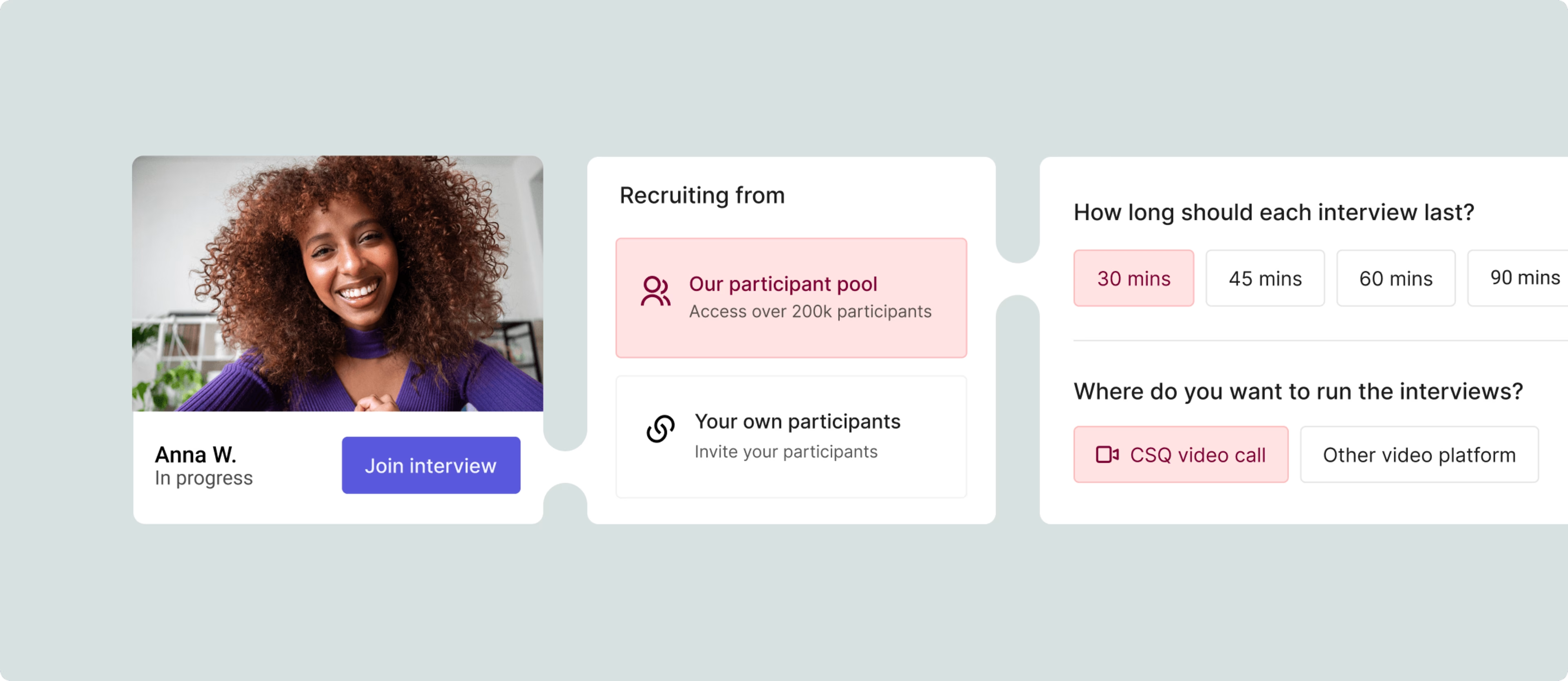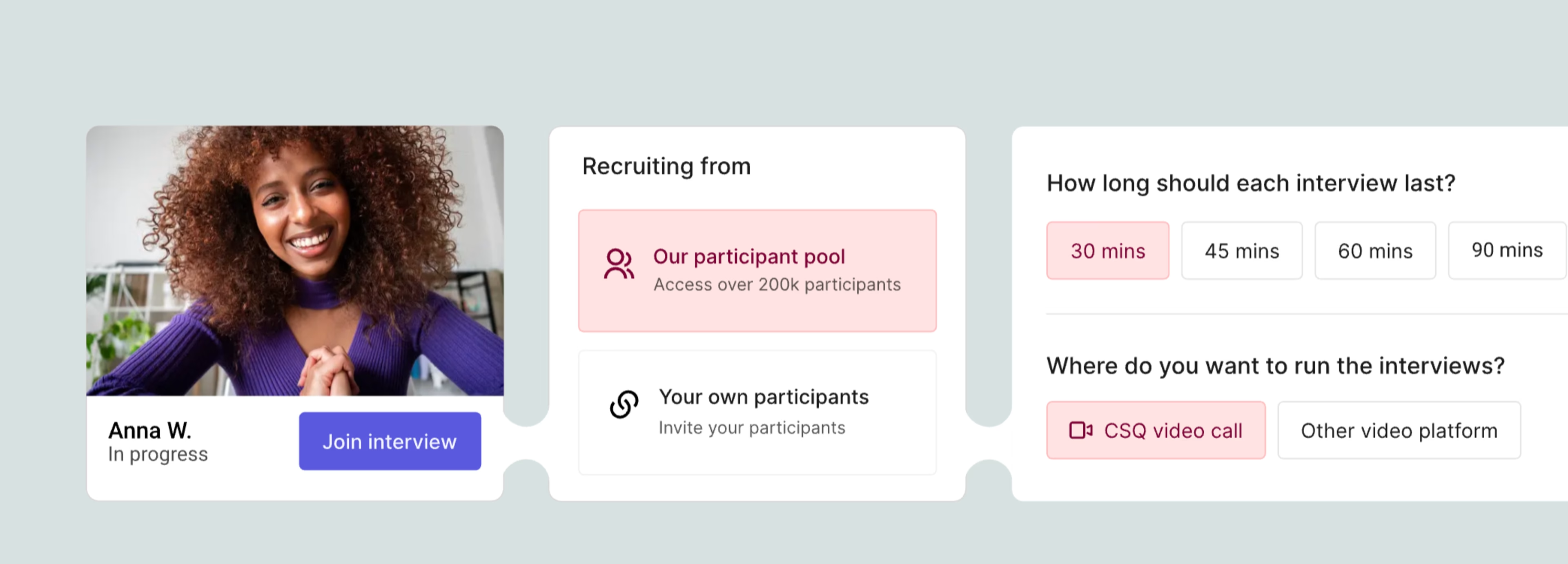When you want to understand your audiences better, user interviews are a foolproof tactic to help you dig deep into their needs, perspectives, and experiences.
But you only get one shot at each interview—so how do you make the most of it?
Follow our step-by-step user interviews guide to get the practical insights you need, every time.
We cover:
Choosing the right interview technique
7 simple steps for conducting insightful interviews
How Contentsquare Interviews helps you automate the process
Choosing the right interview technique
Interviews are the only user experience (UX) research method that lets you dive deep into users’ experiences and perspectives. But to gather user feedback that really moves the needle, you need to:
Probe for insights (while avoiding bias): great interviewers ask research questions that prompt valuable, actionable answers without leading the participant in any direction
Adapt your approach to the interviewee: every interviewee is different—while some are easy to talk to, others are shy or less responsive in their initial answers
Make future analysis easy: without a plan for your interviews, or a way to easily analyze the qualitative data you gain, you’ll struggle to draw meaningful conclusions
With that in mind, preparing for your interviews and honing your interview technique can significantly impact your research outcomes.
💡Pro tip: using AI in user interviews can help you make the most of them. |
How to conduct user interviews in 7 steps
Follow these steps to make the most of your interviews and get actionable insights (while making the experience pleasant for your participants, too).
1. Set your research goals
You know your product or business inside and out, so there’s an ocean of questions you could potentially ask your participants: where do you start? Setting research goals for your interviews helps you narrow down the focus of your questions, ensuring consistency across all your interviews.
Ideally, start by choosing one to three overarching research questions you want answered. For example:
How can we optimize our onboarding process so more users finish it?
How can we get visitors to spend more in our store?
How can we improve on competitors’ products to increase our market share?
Clearly identifying the decisions that the interviews will help you make is a great starting point. I suggest that researchers work backward from the decision they have to make, then identify what you need to know to make that decision. Finally, format the questions for the interview participants based on what you’re trying to learn.
2. Decide what type of interview to run
As outlined in this guide’s introduction, there are several types of interview formats to choose from:
Unstructured vs. semi-structured vs. structured: will you ask the same questions every time in a highly structured interview, or ask questions ad hoc without a structure? For most product teams, a semi-structured interview—where you have some questions prepared but are ready to go ‘off-script’—is the right balance.
Generative vs. contextual vs. continuous: generative interviews ask questions on any topic, contextual interviews host conversations in a specific context (for example, exploring a user’s thought process as they complete tasks in their job), and continuous interviews involve speaking to the same participant multiple times to see how their answers evolve.
Remote vs. in-person: in-person interviews give the interviewer more control of the environment and a better view of the participant. But many teams prefer the convenience of remote interviews, which are easier and cheaper to run—you don’t need to source a dedicated space, and the interviewee doesn’t need compensation for time spent traveling.
Contentsquare Interviews: the ultimate tool for remote user interviews
Contentsquare already offers user behavior analytics tools—Heatmaps, Session Replay, and Surveys. But did you know you can complement these insights with valuable learnings from user interviews, all from the same platform?
With Contentsquare Interviews, our user interviews tool, you can invite users to remote interviews, source from our participant pool of 200,000+ people (or invite your own), and bring in your team members as invisible observers.

Contentsquare Interviews automates the entire user interview process, including hosting
3. Recruit the right participants
To get useful insights from your interviews, you need to speak with the right target audiences. The most appropriate participants will depend on your research goals, for example:
If you want to increase your market share, you’d interview people from your target market who aren’t currently your customers
If you want to optimize your marketing campaigns, you’d interview customers and non-customers from your target audience to learn about their needs and preferences
If you want to increase customer spend in your store, you’d interview both high-spending and low-spending customers—and possibly non-spending visitors—to understand how their needs differ
For most research questions, interviewing five participants from each audience segment or user persona is enough.
Find participants faster with Contentsquare Interviews
Interviews connects you to a pool of 200,000+ qualified interviewees. Select from a range of demographic and personal attributes to find the participants you need—then screen, invite, and pay them automatically in Contentsquare.

Contentsquare Interviews helps you screen participants with specific educational and professional backgrounds
4. Plan your questions
Your questions should help you explore user pain points, experiences, and preferences relevant to your research questions. Use these best practices when planning questions—keep them in mind when you’re asking follow-up questions on the fly, too.
There are six main types of questions you could ask in user interviews. To structure your interview naturally, ask them in (roughly) this order:
Screening questions: How frequently do you buy products online?
Awareness questions: How did you find out about our brand?
Expectation questions: How did you think using our product would affect you?
Task-specific questions: How was your checkout experience?
Experience questions: How can we improve our checkout page?
Concluding questions: If you could change one thing about our checkout page, what would it be?
Use closed-ended questions cautiously
Closed-ended questions only allow the interviewee to answer in a specific way. For example, the question, "Do you like our feature idea?" can only be answered yes or no. Questions like this make it difficult to get valuable insights from participants.
However, there are times when closed questions can be useful. For example:
When using structured interviews to gather quantitative data for analysis
When asking interviewees to specify which of several options they prefer (see: concept testing)
When setting up an open-ended question that would further explore the interviewee’s preference or perspective
Ask open-ended questions for deeper insights
When you want to get the user to be descriptive in their answers, open-ended questions are the way to go. For example:
What was your experience like when using our product?
What led you to visit our website?
What would you change about our product?
All these questions allow users to answer however they want, opening the door to valuable (and often unexpected) insights.
Phrase questions so they don’t ‘lead’ interviewees
Leading questions force the interviewee to answer in a certain way and can bias your data. Let’s examine what leading questions look like—and how you can rephrase them.
Leading question | Problem | Rephrased version |
|---|---|---|
What was your favorite part of the onboarding process? | Assumes the user feels positively about something, and leads them to answer in line with that assumption | What part of the onboarding experience stood out most to you? |
What do you dislike about our competitor’s product? | Assumes the interviewee dislikes something | What would you change about our competitor’s product? |
How easy was the product to use? | Assumes the interviewee found the product easy to use | What was your experience of using the product? |
How often do you buy groceries online? | Assumes the person buys food online. The interviewee might feel like they ‘should’ buy online and answer accordingly. | How do you usually buy groceries? (Follow-up questions might ask how often they buy online.) |
Would you buy our product? | Pressures the interviewee to say they would buy the product out of politeness | Imagine you stumble across a product like this one when looking for a solution. What would your reaction be? |
Pro tip: Ask questions about what users did in the past (not what they would do in future)
We humans aren’t good at predicting the future. If you were to ask interviewees, “How often would you go to the gym if you joined one?”, many would optimistically answer, “Several times a week.”
Realistically, many people won’t follow through with their fantasy workout regime (RIP our New Year’s resolutions 🪦).
For this reason, it’s often better to ask questions about the past—like, “Were you a member of a gym previously? How often did you visit when you were a member?”
Structuring your interview to uncover your audience's jobs to be done
The jobs-to-be-done (JTBD) framework helps you discover what people are trying to accomplish when using a product. This framework gives you a clear sense of why users choose your product and what their decision-making process looks like.
Structure the interview to follow the journey that the user goes through—from starting to work on a goal to evaluating and choosing a solution.
🛠 Identifying the job: what were your users trying to do?
‘What are you trying to accomplish by using [x product or service]?’
‘What goals or objectives does [x product or service] help you accomplish?’
‘What problems does [x product or service] help you prevent or resolve?’
👋 Firing a solution: what was it about their situation that led them to look for a new or different solution?
‘When did you first start thinking you need a tool?’
‘When did you realize your previous tool wasn’t doing the job?’
🤝 Hiring a new solution: what was it about the new solution that led them to try it?
‘What was appealing about [x product or service] that you found?’
✋ Habits holding them back: what prevented them from switching earlier?
‘Was there anything that made you hesitant in leaving behind [x product or service]?’
😓 Anxieties of the new solution: what anxieties do they have about switching to something new?
‘Did you have any concerns or hesitations about trying out [x product or service]?’
5. Run the interview
Now’s your chance to shine! Follow these best practices to run a great interview.
Set the scene: at the start of the interview, your job is to help your interviewee feel comfortable. So make some friendly small talk, thank your interviewee for coming, and let them know what will happen next.
Hit record: recording your interview is a no-brainer, making it easy to analyze and share the interviews later. It also means you can relax without scrambling to write down everything participants say. (Don’t forget to ask for participants’ permission before hitting record.)
Note down important responses: even if you’re recording, notes are still helpful. When an interviewee says something particularly significant, make a note of the time so you can revisit their comment later.
Embrace awkward silences: when interviewees don’t answer straight away, resist the urge to immediately move on to another question.
Interviewers may get uncomfortable and try to fill the silence, which can result in leading questions—like “Do you think X or Y or Z?”—or multiple questions back-to-back. Interview respondents often need some time to process a question, so I encourage interviewers to embrace the awkwardness. If the participant doesn’t understand the question, they will tell you, but they usually just need time to formulate a response.
Roll with any mistakes: if participants make mistakes, like calling your product (or you) by the wrong name, don’t correct them. Interrupting their flow could make them lose their train of thought.
Listen carefully and ask follow-up questions: participants won’t always give you juicy insights with their first answer, but they will often give you ‘clues’ that you’re onto something. That’s why one of the most important interview skills is active listening. Ensure you concentrate on their answers—not on frantic note-taking—then ask follow-up questions to learn more.
Gently probe non-responsive participants: some participants will give you very short answers—but don’t give up on them. Sara Hefny, Senior Product Researcher at Contentsquare, says the magic phrase “Can you tell me a little more about what makes you say that?” encourages more detailed responses and helps you understand the deeper motivations and reasoning behind users’ attitudes and behaviors.
Keep neutral or positive body language: avoid any closed-off body language that might lower the energy of the conversation, like folding your arms. Avoid frowning, leaning back in your chair, or looking away, and try to make occasional eye contact with users.
Give encouragement: being interviewed can feel a little strange, and encouragement may help participants open up and share more.
To create an atmosphere of confidence and comfort, encourage your interviewee (genuinely) as they respond by showing real interest and affirming that they’re giving you what you need. A simple “That’s so interesting; tell me more!” or “That’s a great answer!” or “You really know this space” can work wonders to get the person you’re talking to feeling like they’re succeeding. Remember that they’re often as nervous as you might be.
6. Analyze your interview data
You won’t always notice important trends and insights during user research interviews, but with a recording or transcript, you can perform in-depth analyses later.
💡Pro tip: Contentsquare Interviews automatically records and transcribes your user interviews for you, so you can concentrate on getting the most out of your conversation.
Do a quick debrief immediately after the interview
You’re sure to forget some of what happened in your interviews, so write a quick summary of each conversation. These summaries are a great starting point when it comes to analysis.
Review transcriptions
When analyzing your data, start by reading interview transcripts to save time. If you need to better understand the emotions behind an interviewee’s statement, check the recording to see and hear how they spoke.
Take notes of important statements, but ensure your notes directly reflect what interviewees say—not how you interpret their comments.
Look for themes across your interviews
Sara explains how she analyzes interview data:
Gather all your notes in one place and put each thought or response on separate sticky notes (either in a digital tool like Miro or on actual stickies), and start to divide them into broader themes. Once the notes have been grouped into larger themes, you can begin to look for sub-themes or patterns. Focusing on one theme at a time, look for commonalities or contradictions among the responses and create sub-groups of related observations, which we call clusters. This method is also called affinity mapping or affinity diagramming—and the goal is to connect pieces of evidence to create a broader insight.
7. Share your findings with colleagues
Now that you’ve been through your data and unearthed fascinating insights, it’s time to share them with your team. Prepare a short report in your preferred format and include key snippets from your user interviews.
Pro tip: Use Contentsquare to bring data to your team
Contentsquare helps you automatically share interview data via apps like Slack and Microsoft Teams to get buy-in for your recommendations. Send time-stamped video notes with a click, or create video clips of juicy insights from your participants.
How to automate your interview processes with Contentsquare Interviews
Follow these steps to have Contentsquare Interviews handle your recruitment and scheduling—freeing up more time for interviewing and analysis.
Step 1: create a project
Fill in some basic details about your project, starting with its name. Here, you can add an internal description for your team, plus a public description that participants will see.
![[Visual] Engage step 1](http://images.ctfassets.net/gwbpo1m641r7/6Tnnp2GNIVKJVimxi355Re/3d81db53607cc566cae06b5d56816eca/Engage_step_1__1_.png?w=1920&q=100&fit=fill&fm=avif)
Step 2: invite participants
Next, invite your participants from your own network, or use Contentsquare’s participant pool. Automate recruitment by selecting how many participants you want and their compensation—Contentsquare will find the right people for you.
![[Visual] Engage step 2](http://images.ctfassets.net/gwbpo1m641r7/6FUPV9g0GP7LU7CfsAKGEM/7590918d8c99471681f50d42d294bccf/Engage_step_2__1_.png?w=1920&q=100&fit=fill&fm=avif)
Step 3: configure project settings
Tell Interviews when you want to do your interviews. You can even connect your calendar so you don’t get double-booked.
![[Visual] Engage step 3](http://images.ctfassets.net/gwbpo1m641r7/1WirQYKspOm9XGlVHuTWxs/382a1e8d33aa9de2d623a71035d56ed7/Engage_step_3__1_.png?w=1920&q=100&fit=fill&fm=avif)
Step 4: set your criteria for recruitment
If you’re using Contentsquare for recruitment, select from a wide range of demographic and professional background criteria. For example, you could request women aged 40+ who live in the USA and work in healthcare.
![[Visual] Engage step 4](http://images.ctfassets.net/gwbpo1m641r7/7HgQBM5q0NptPPbnylCeV3/dd0e21649bd734c43d4063f2d865b3dd/Engage_step_4__1_.png?w=1920&q=100&fit=fill&fm=avif)
You can also set up screening questions to ensure Contentsquare only invites people relevant to your research.
Step 5: let Interviews handle invitations, scheduling, and compensation
If you recruit from your own network, Interviews generates a link you can use to invite contacts. Or, if you’re recruiting from the Contentsquare participant pool, Interviews automatically finds, screens, and schedules interview participants for you.
![[Visual] Engage step 5](http://images.ctfassets.net/gwbpo1m641r7/6Z6SxfMUP4ubBIVXDuTPPm/37f69e2111b6b7a9157a192581a03cda/Engage_step_5__1_.png?w=1920&q=100&fit=fill&fm=avif)
When the interview is over, mark it as complete, and Interviews will pay the participant—leaving you free to focus on your analysis.
To conduct effective user interviews, pay attention to the details
Great user interviews often feel like a chat with a friend, with the conversation flowing easily. But interviews exist to give you invaluable user data. That means you need to pay attention to details you wouldn’t usually think about—like the way you phrase questions and the small ‘clues’ in your respondents’ answers that prompt you to probe further.
The best way to catch these small details is through careful preparation. By establishing clear goals and questions in advance, you’ll know what to ask your participants and what to listen out for. With the right tools, you’ll capture every important detail—and spot those game-changing insights in your participants’ responses.

![[Visual] Contentsquare's Content Team](http://images.ctfassets.net/gwbpo1m641r7/3IVEUbRzFIoC9mf5EJ2qHY/f25ccd2131dfd63f5c63b5b92cc4ba20/Copy_of_Copy_of_BLOG-icp-8117438.jpeg?w=1920&q=100&fit=fill&fm=avif)